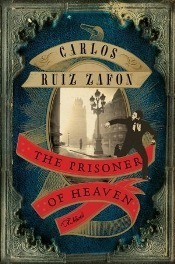On Carlos Ruiz Zafón's The Prisoner of Heaven, and my approach to reading series
 Sometimes I like reading novels in series out of order. Curiously, this ties in with my interest in historical fiction. Not only do I enjoy following characters and their adventures in their proper chronological progression, but I also like starting with the newest volume and learning later about the characters' past histories – which sit waiting for me to discover them via earlier books. When I do this, I know there will be references I won't pick up on, but if the author has done a good job, they'll intrigue rather than perplex me.
Sometimes I like reading novels in series out of order. Curiously, this ties in with my interest in historical fiction. Not only do I enjoy following characters and their adventures in their proper chronological progression, but I also like starting with the newest volume and learning later about the characters' past histories – which sit waiting for me to discover them via earlier books. When I do this, I know there will be references I won't pick up on, but if the author has done a good job, they'll intrigue rather than perplex me.Despite the fact that many friends name The Shadow of the Wind as an all-time-favorite, I hadn't read anything by Carlos Ruiz Zafón until now. A note at the beginning of The Prisoner of Heaven describes it as an "independent, self-contained tale" and that "each individual instalment in the Cemetery of Forgotten Books series can be read in any order." In other words, starting with volume three is fair game, so that's what I did.
The novel opens in a place where any bibliophile would feel comfortable. It's Christmastime in Barcelona of 1957, where Daniel Sempere lives with his beautiful wife Bea, his new baby son, and his father. Times are tough, and the Sempere & Sons bookshop needs to bring in more business. When an elderly stranger with a heavy limp drops in to buy an expensive illustrated copy of The Count of Monte Cristo, however, Daniel finds his troubles have only begun. The visitor has a message for Daniel's good friend Fermín Romero de Torres which he leaves inscribed in the book – and which has dark implications for Fermín, he of the normally jovial outlook and deliciously phrased ripostes. I love how Ruiz Zafón can present Fermín’s appearance in just a few words; who can resist knowing more about a funny guy whose “body seemed mostly composed of cartilage and attitude”?
Fermín’s backstory is exactly what the novel proceeds to reveal. This story-within-a-story is set toward the end of Spain’s Civil War, circa 1939, deep within Montjuïc Castle: a fortress overlooking Barcelona where political prisoners languish, die, and rot, forgotten by most, and with no realistic hope of escape. With a setting out of a sinister nightmare, and a crafty, compelling plotline with a strong nod to Dumas, the pages essentially turn themselves. As they all speak amongst themselves in their dank, filthy cells, the personalities of Fermín and his fellow “tenants”– which include a novelist named David Martín – spring forth with grim, sarcastic humor. It’s a testament to the author’s storytelling prowess that I found my attention transfixed by these characters while simultaneously wanting to get the hell out of there.
That’s all I’ll say about what happens. Does the novel stand on its own? Well, yes and no. While The Prisoner of Heaven does tell a self-contained story, it begins amid a larger tale and doesn’t end at the end, either. (There will be a fourth novel; I’m not giving anything away by saying that.) As a short book with a swift-moving 278 pages, it feels very much like an interlude rather than the full experience. The “Cemetery of Forgotten Books” hinted at within the initial note is mentioned, although this mysterious place didn’t have anywhere near the impact on this newcomer I felt it would have, if I had read the The Shadow of the Wind and The Angel’s Game first.
If the point to my reading it was to whet my appetite for the earlier books, though, it did the trick. I'll be getting to them sooner now rather than later. I also can’t help but think how much fun this novel must have been to write, and to translate. (Lucia Graves' skillful translation is anything but stiff.) It’s a novel for those who love words, inventive turns of phrase, and literature as a whole.
The Prisoner of Heaven was published by Harper on July 13th at $25.99 in hardcover; in the UK, the publisher is Weidenfeld & Nicolson (£16.99).
Published on July 27, 2012 06:00
No comments have been added yet.



